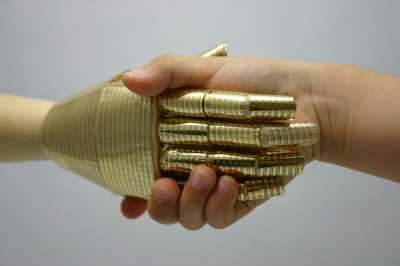 Electronic skin is flexible, stretchable material with a layer of circuitry on top. It is currently a research novelty, but has a lot of people excited because of its potential to be wrapped around the metal frames of robots, to be used to make clothes with embedded solar cells, and to sense the electrical activity in a person’s beating heart by conforming to the organ’s shape. Displays are the screens of our televisions, laptops, tablets and mobile phones. So what’s the connection?
Electronic skin is flexible, stretchable material with a layer of circuitry on top. It is currently a research novelty, but has a lot of people excited because of its potential to be wrapped around the metal frames of robots, to be used to make clothes with embedded solar cells, and to sense the electrical activity in a person’s beating heart by conforming to the organ’s shape. Displays are the screens of our televisions, laptops, tablets and mobile phones. So what’s the connection?
First take a look at the display industry. It makes billions of dollars of displays each year because of the manufacturing processes that Applied Materials has developed and Samsung and others have streamlined: deposit high-quality, reliable electronics, on enormous sheets of glass. These sheets of glass, which are as large as garage doors, but only just a little thicker than paper, are then chopped up into large-screen liquid-crystal display televisions. The profits come from the narrow margin between efficiently rolling out millions of LCD screens and the cost of building an LCD factory, about $3 billion, its maintenance, and its materials. The only way the LCD business makes money is volume. Right now, volume is high, and this makes displays cheap for consumers.
Next, take a look at electronic skin. It consists of the precise placement of electronics on flexible, stretchable materials. One way that researchers put electronics on these materials is to print them*, using inkjet printers or other similar technology. Printed electronics tend to be made of organic ink, similar to the inks used to make organic light-emitting diodes, or OLEDs.
Now, the display industry has been interested in ramping up production of OLED displays for many years. The benefits of OLEDs over LCDs are these: a more vivid image, a thinner, lighter, more energy-efficient screen, and a more streamlined, and ultimately cheaper, manufacturing process. One problem is that there’s not been a real financial incentive to put significant resources into increasing production of OLEDs while the LCD market is still producing profits. Another problem is that the technology to print large-scale OLED displays is still being fine-tuned. Currently, OLED printers simply can’t put all the teeny tiny diodes where they need to be on a giant piece of glass.
But, the technology issues are being seriously addressed by big companies like Samsung, and smaller startups like Kateeva. And as far as the financial incentives go, Samsung, for one, seems to have some motivation. At the recent Society for Information Display conference, the VP of Samsung Mobile Display promised to put resources into OLEDs in the coming years, thanks to the growing popularity of 3D-TV, an application in which OLEDs shine.
So, here’s the connection between displays and electronic skin. If the display industry can work out the kinks of printing high-quality, large area displays, then those who work with electronic skin will directly benefit. Right now, researchers have to make small batches of stretchable circuits. If there’s any hope for commercialization, they need to be made at much higher volumes, and the tools to make them need to come down in cost. I talked to Sigurd Wagner of Princeton yesterday about stretchable electronics research and he had this to say about how the display industry affects his work:
What’s happened is the display industry is so huge right now that when they embrace a technology they do it for cost reduction. They’re looking for other components, but main driver is cost reduction. When they embrace a technology like printing, it will go into fast forward. Such large resources will go into it. For nothing else, just for that reason, you always hope some new technology is embraced by someone in the display industry. In my work I’m living off that…Even in your research planning you depend on the display industry.
The industry behind the humble LCD screen, then, could hold the key to making electronic skin a reality.
Relevant Links:
Samsung OLED: http://amoled.samsungsdi.com/
Kateeva: http://www.kateeva.net/
Samsung’s 3DTV OLED push: http://kategreene.net/?p=577
Sigurd Wagner: http://www.ee.princeton.edu/people/Wagner.php
The Hunt for the Perfect Screene: http://gizmodo.com/5435257/the-hunt-for-the-perfect-screen
*Printing is used mainly for organic circuits, which are slow compared to silicon circuits. Organic circuits are used as sensors that track light, temperature, pressure, and humidity. Silicon circuits, which are used for computation and wireless communication can also be put onto stretchable material, but in a process that involves transferring thinned-out, specially designed circuits from a rigid substrate to a stretchable one. Eventually, researchers expect that organic and silicon electronics could be built together, on the same stretchable device, but for now they are fabricated separately.
